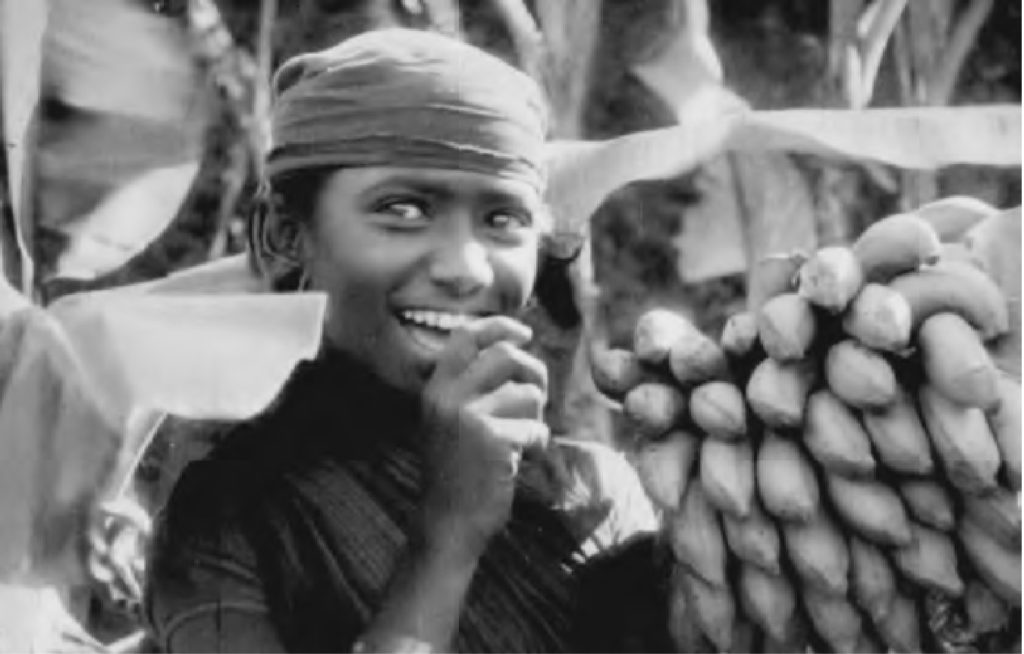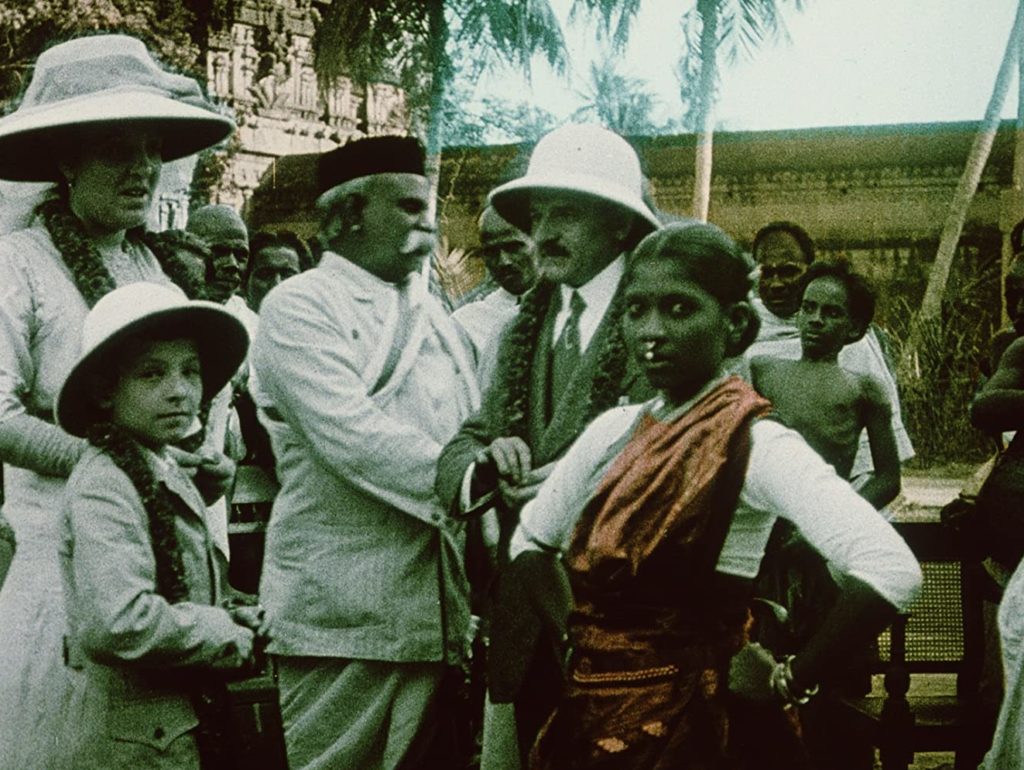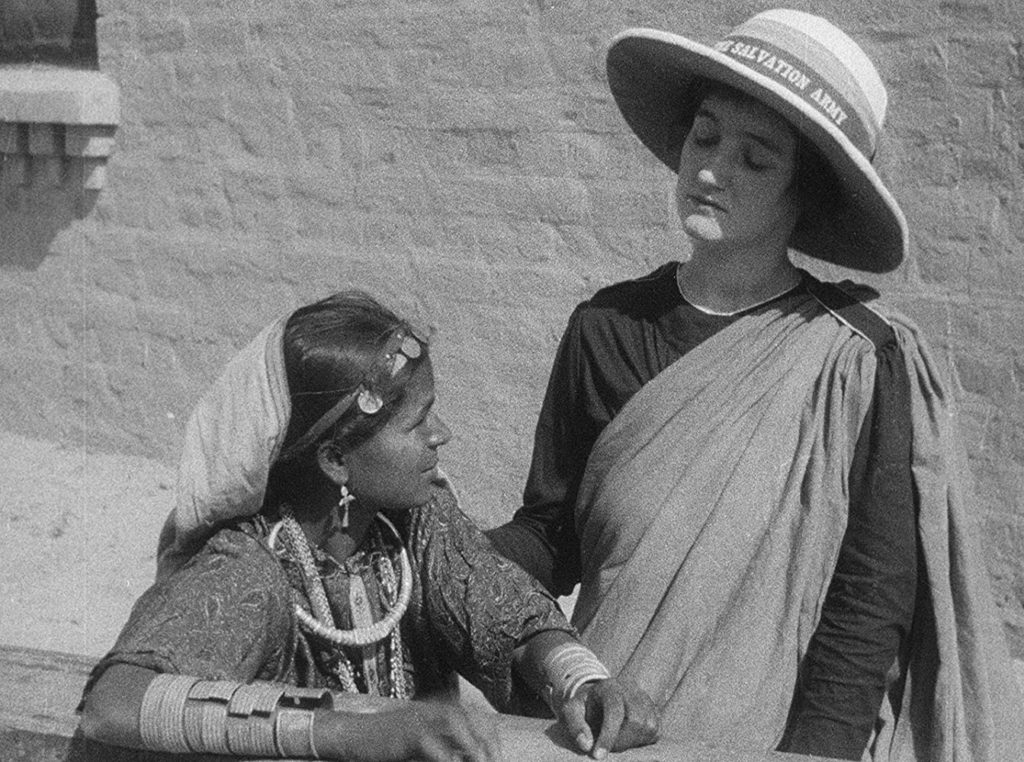Directed by Sandhya Suri
Produced by Nicola Gallani
72 minutes, Color and Black & White
Icarus Films, 2018
Reviewed by Coonoor Kripalani

This seventy-two-minute silent documentary film, spliced together and edited by director Sandhya Suri from archival British Film Institute (BFI) clips, cleverly juxtaposes scenes of the daily lives of Indians with that of the activities of the British. Some sections are from news footage, while large parts are drawn from family movies shot by expatriate families, giving the film its greatest value. It provides a firsthand look at how the colonialists lived and how they viewed the empire in India and its people in the first half of the twentieth century.
It opens with a scene shot on the ghats (steps leading down to the river) of Benaras (present-day Varanasi, mistakenly labeled as the banks of the River Ganges in Calcutta!) in 1899, said to be the oldest-known film clip from India. Strikingly, this montage reveals that the city looks pretty much the same 120 years later, with people performing the same rituals on the ghats even in the present. Depictions of everyday life in 1906 are exoticized by showing a baby being bathed, an expressionless little Indian girl being dressed in a sari, and a man holding two leopard cubs, one in each arm. Further along the years, exotic activities recorded range from a performer and his little boy walking on sword blades in Bikaner to what seems like dancers performing at the Hemis Festival in Ladakh to wild horsemen converging on a stranded Englishman in a desertlike area and helpfully towing his car.
Scenes of rural India show, in color-tinted film, ripe bananas being eaten in the fields and men climbing coconut trees to pick coconuts. Other scenes show nautch (dancing) girls in temples performing as a British family undergoes some rituals, while mundane activities like shaving, and socializing conducted on charpoys (a wooden cot with a strung or woven middle), bathing, and cooking in the open are all documented.
In contrast, the great Delhi Durbar (court of Indian emperors), held in 1911 for King George V and Queen Mary, shows the pomp and splendor of the British raj, mimicking both the splendor of the Mughal Empire and Indian princes, as well as that of the British court, and creates awe in the beholder. Each of the Indian princes was called to pay respects to the king according to protocol. This film captures the show of defiance by the Gaekwad (Maharaja) of Baroda, who famously flouted protocol, thus insulting the king. Despite his progressive ideas and support for the national struggle, the Gaekwad had to write an apology and fell out of favor with the British.

Another segment documents the uniforms and costumes of retainers seen in various princely states, as well as different turbans and pugrees (headgear), contrasting these with a Caucasian man wearing a bowler hat before shifting to the grand 1920 Delhi Durbar to welcome the prince of Wales. This newsreel shows the large crowds that turned out to greet him, the resplendent robes of the Indian princes, and Indian society women wearing their saris to look like Western dresses, with white socks and shoes—no doubt the fashion statement of those years. Of course, the newsreel makes no reference to the discontent that was brewing at the time, demands for self-government, the related activities of the anarchists, or the fact that Gandhi had returned from South Africa the year before and was himself drawing huge crowds as he toured the length and breadth of the country by train.
Several vignettes in this film inform us of the pastimes of the British in India, such as putting on theater such as the risqué and comic musical, The Rollicking Rajah. The family antics of British military and civil servants appear in an endearing personal film of retired Colonel George Craster, Chief Staff Officer in Jaipur. The colonel appears riding in the film, as well as playing with the family dog and his daughter. The child’s activities are also shown, and the segment ends with her dressed like an Indian princess. British people wearing Indian costume appears to have been a common amusement, as it occurs more than once in the film.
The British also found the modes of transport they used in India worth recording: the viewer sees memsahibs (white women) riding on camelback, climbing onto an elephant by walking up its trunk, riding in a palanquin, and being carried across a river on an upside-down charpoy. Men are seen enjoying the great outdoors as they crouch through the jungle (probably stalking prey while on shikaar [hunt]), bicycling behind a parade of elephants on the beach, canoeing in the waves, riding on elephant back for shikaar, pushing a shikara (type of boat used in Kashmir) out of the water, and walking up mountains carrying staffs. Other scenes show couples in hill stations being transported in rickshaws, with two men pulling the vehicle from the front and two men pushing it from the rear.

A tiger hunt in the Gir Forest, sponsored by a Raja, is considered quite an adventure, documented here in all its extravagance, with countless elephants carrying the hunters, escorted by teams of retainers in elegant uniforms. The cameraman rather fortuitously witnesses and records a fight between a lion and tiger—the possibility of which has all but vanished in the present, given shrinking forests, the hunting of these species in the early twentieth century, and an almost-extinct lion population in India.
This section provides a glimpse into attitudes of the colonial masters toward their subjects. The beaters for this hunt are said to be from the Crow tribe, described as a criminal tribe that seeks to do evil so they can be reborn as crows! In fact, what is very visible in the film is the poverty of this tribe, obvious from the tatters that cover them. In 1871, the British enacted the controversial Criminal Tribes Act, which listed certain tribes and communities as being “criminal,” without acknowledging that their livelihoods had been snatched from them due to colonial intervention. The stigma that attached to this classification was addressed in independent India, but had already created its own set of biases.
Another moving scene shows a Salvation Army woman worker making a tribal woman remove all her jewelry as an act of “giving to Christ.” After this, the tribal woman is distraught. Moving on to temples of India, “the Hindoo” religion is introduced as “weird, mysterious, and bizarre,” which allows no conversion and is incomparable to any other world religion. Such tropes became the norm for many in the West and continued well into the decades, as evidenced by a clip from a 1940s durbar of the princes, “the firm friends of the Raj.” When describing the pageantry and “robes stiff with gems,” the commentator remarks, “While we are only entertained by something new, the Oriental dwells and delights in the past.”
Useful for scholars, educators, and students to view is the contrast in the recreation of ordinary Indians at a village fair, compared to Indians in what appears to be the Bengal Club, probably at the races, as the more Western-educated classes begin to cultivate the social behavior of their colonial masters. By the 1930s and after, we see an intermingling of Indians—both men and women—with the British at social events, such as the Viceroy’s Garden Party.
As the 1920s and ‘30s bore witness to Mahatma Gandhi’s nonviolent noncooperation, the British government in India retaliated with propaganda against the “mischief-making” Congress Party. This section includes some well-known footage of Gandhi’s 1930 Dandi Salt March, contrasting it to a Maharaja traveling to cooler climes, being carried all the way in a palanquin, accompanied by girls dancing nonstop alongside while his rani follows in a palanquin of her own.

In the midst of all this, Suri throws in a hitherto-unknown early documentary by legendary director and filmmaker Bimal Roy on the humble kerosene tin. Another segment focuses on Sabu, the international Hollywood star who hailed from India. Also included is a snippet of wartime propaganda, vilifying Adolf Hitler and glorifying the Kulu Valley’s mountain ranges, rapids, and peaceful cow herders, who were pressed into military service for the war effort. Rare footage of Gandhi’s peace mission to Noakhali in 1946 by his grandson, Kanu, is a treat to watch. It shows not only the Mahatma, but also includes a number of other senior Congress leaders and freedom fighters, who joined Gandhi as he sought to reconcile bitter Hindu–Muslim animosities.
Bearing in mind that a number of colonial officers and businessmen were young men and women from ordinary walks of life in Britain, seeking to make their fortunes in India, their arrival in the vast bustling country of contrasts would certainly arouse a sense of curiosity. This film provides some insights into that curiosity by showing what amused them and seemed noteworthy and unique enough to them to document on film. Many private moments of fun are captured, such as when a man stuffs an entire sandwich into his mouth in one go, another grabs the oars of a boatman on the River Ganges, or two men climb up a peak and turn around in synchrony to show the majesty of the mountain range behind them. Some scenes would benefit from further explanation or commentary, such as the one toward the end showing an Indian feast being served to a large group of Caucasians. Provided that high school and university students are already introduced to at least some aspects of the history of colonialism in India, this film will be well worth a watch for them, followed by a class discussion on the nuances, activities, and attitudes of the British rulers of India as depicted in the film.

